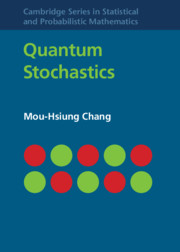Book contents
- Frontmatter
- Dedication
- Contents
- Preface
- Introduction and Summary
- 1 Operator Algebras and Topologies
- 2 Quantum Probability
- 3 Quantum Stochastic Calculus
- 4 Quantum Stochastic Differential Equations
- 5 Quantum Markov Semigroups
- 6 Minimal QDS
- 7 Quantum Markov Processes
- 8 Strong Quantum Markov Processes
- 9 Invariant Normal States
- 10 Recurrence and Transience
- 11 Ergodic Theory
- Bibliography
- Index
2 - Quantum Probability
Published online by Cambridge University Press: 05 February 2015
- Frontmatter
- Dedication
- Contents
- Preface
- Introduction and Summary
- 1 Operator Algebras and Topologies
- 2 Quantum Probability
- 3 Quantum Stochastic Calculus
- 4 Quantum Stochastic Differential Equations
- 5 Quantum Markov Semigroups
- 6 Minimal QDS
- 7 Quantum Markov Processes
- 8 Strong Quantum Markov Processes
- 9 Invariant Normal States
- 10 Recurrence and Transience
- 11 Ergodic Theory
- Bibliography
- Index
Summary
Complex Hilbert spaces play an important role in the description of quantum systems. In fact, with every quantum system there is associated an infinite dimensional or a finite dimensional separable complex Hilbert space ℍ that consists of the states of the quantum system. In physics terminology, the Hilbert space ℍ is usually referred to as the space of (pure) states. Throughout this monograph, the mathematical description of a quantum system shall be based on a certain complex (separable) Hilbert space ℍ, and therefore the quantum system will simply be denoted by ℍ. The quantum system ℍ is said to be a finite-dimensional system if ℍ is a finite-dimensional complex Hilbert space. Otherwise, the quantum system ℍ is said to be an infinite-dimensional system.
The Hilbert space ℍ representing a composite quantum system that consists of n subsystems is a tensor product of the Hilbert spaces of n component systems described by ℍ1, … ℍn, i.e., ℍ = ℍ1⊗ … ⊗ ℍn. In the theory of Hilbert spaces, a tensor product of Hilbert spaces is a way to create a new Hilbert space out of 2 (or more) Hilbert spaces. In the following, we illustrate the concept and construction of tensor product ℍ ⊗ 핂 of only 2 Hilbert spaces ℍ and 핂. The concepts and constructions can be easily extended to more than 2 Hilbert spaces such as ℍ1 ⊗ ℍ2 ⊗ … ⊗ ℍn. Recall that the tensor product of ℍ with 핂 denoted by ℍ ⊗ 핂 is a new Hilbert space that consists of elements ϕ ⊗ φ (ϕ ∈ ℍ and φ ∈ 핂) and is equipped with the Hilbertian inner product
〈·, ·〉ℍ⊗핂:(ℍ ⊗ 핂) × (ℍ ⊗ 핂) → C
defined by
〈ϕ1 ⊗ φ1, ϕ2 ⊗ φ2〉ℍ⊗핂 = 〈ϕ1,ϕ2〉 ℍ〈φ1,φ2〉핂, ϕi ∈ ℍ and φi ∈ 핂 for i = 1, 2.
- Type
- Chapter
- Information
- Quantum Stochastics , pp. 50 - 80Publisher: Cambridge University PressPrint publication year: 2015



